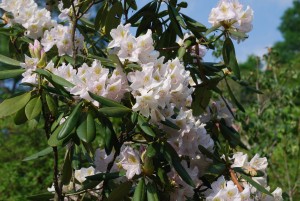Your most important decision is pedigree. So many varieties to try, and the “H-1 ironclad”cultivar class is a good starting point. Here are five: rose pink (cv. ‘English Roseum’), lavender pink (cv. ‘Roseum Elegans’), light pink (cv. ‘Janet Blair’), white (cv. ‘Chionoides’) and dark purple lavender (cv. ‘Lee’s Dark Purple’).
Success with rhododendrons follows three planting rules: sunlight exposure, soil amending, and watering needs. The cultivar must be heat and drought tolerant in summer and pleased with its soil conditions year-round. Direct morning sunlight and mostly afternoon shade are winning combinations year-round. The northeast or southeast corner of a home, garage or large tree serves as an ideal planting site.
The soil must be well-drained, acidic and high in humus. At planting time amend the soil, adding lots of organic matter such as peat moss and compost. Organic amendments tend to lower the soil pH, preferably to 5.5 or lower. After planting fertilize rhododendron(s) bimonthly with an acidic fertilizer such as Miracle Gro™, Miracid™ or an equivalent. Do not feed after mid- August.
Any hint of poor soil drainage generally results in root disease problems like phytophthora and pythium. These fungal pathogens thrive in poorly drained soils. The pesticide treatment costs to attempt to save a pathogen infected rhododendron is high.


 Posted in
Posted in 
